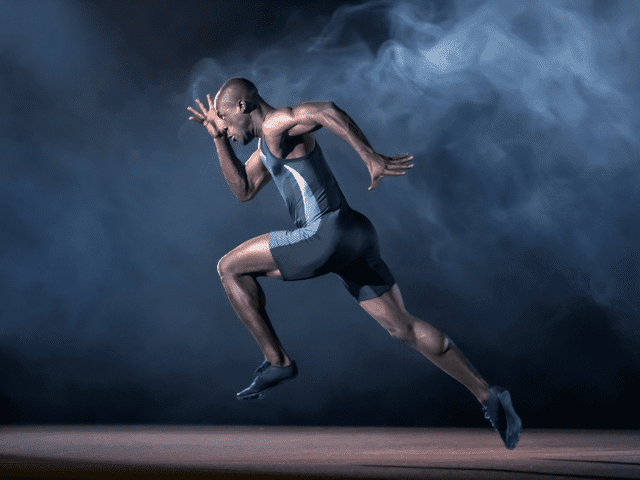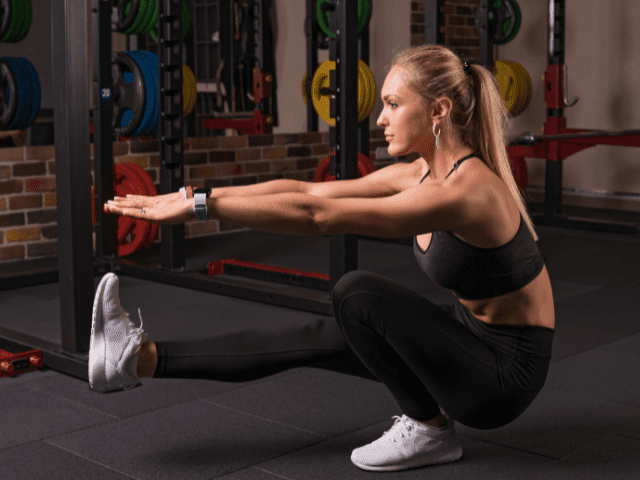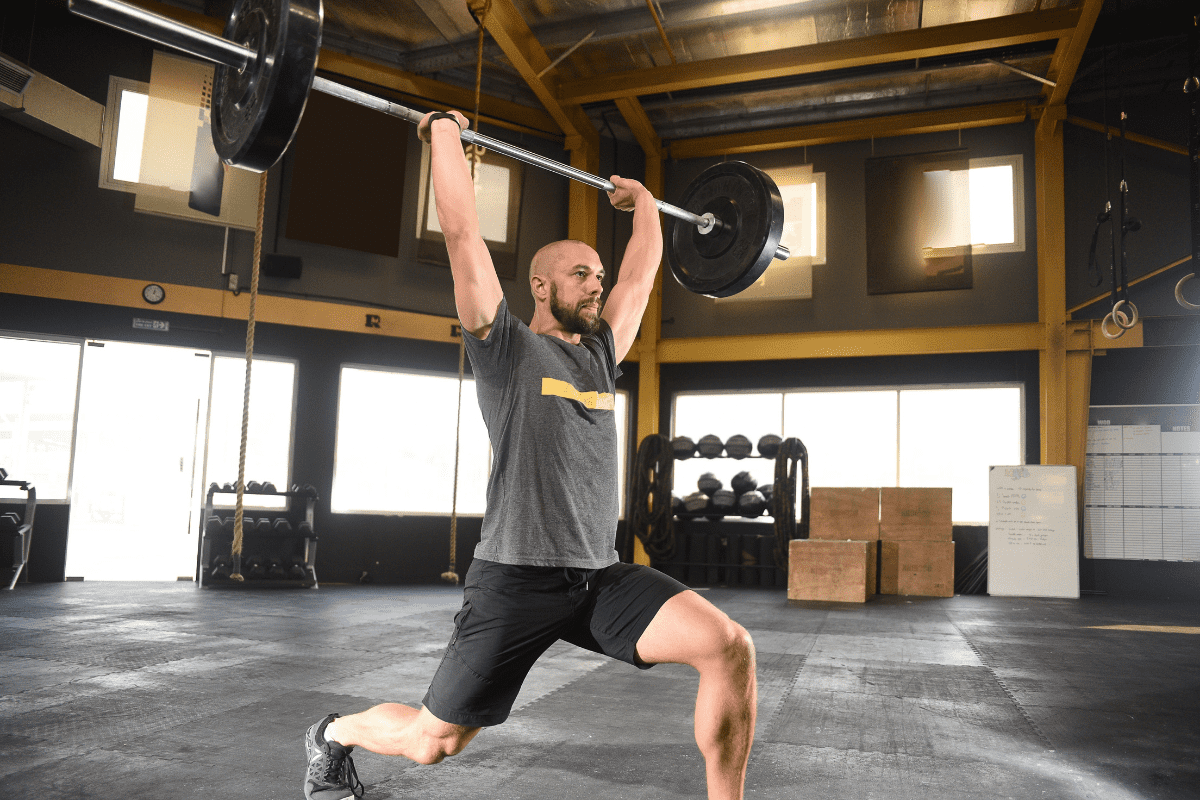Reverse Overhead Lunge (How To, Muscles Worked, Benefits)
The Reverse Overhead Lunge is a slightly more technical version of the popular Barbell Lunge. Instead of placing the bar on the back like a back squat, the bar is held overhead in the same position as an overhead squat.
Holding the bar overhead adds an element of shoulder stability during the movement as well as fixing one of the most common issues lifters have with Barbell Lunges – not keeping the torso upright.
Lack of mobility (or just poor technique) causes many lifters to hinge way too far forward while lunging causing unnecessary stress on the low back. Holding the bar overhead helps to correct this problem because maintaining that position becomes extremely difficult if the torso is not kept mostly vertical.
You will most likely have to use less weight than a regular Barbell Lunge, but the added shoulder stability work (and the potential to help correct technique flaws) make the Reverse Overhead Lunge a great variation to add to your routine.
In this guide I’m going to teach you how to properly do Reverse Overhead Lunges, what the benefits are along with a few alternatives in case you need them.
How To Reverse Overhead Lunge
Equipment Needed
- Barbell
- Bumper Plates (or Steel Plates as long as you don’t drop the bar after sets)
- Squat Rack (Not completely necessary as you can clean and press a bar onto shoulders if needed, but a rack is going to make this a whole lot easier especially if lifting heavier weight)
Step-by-Step Instructions
- Unrack the barbell similar to how you would unrack a bar for a back squat.
- Step away from the rack to give yourself enough room to perform the movement.
- Slide your hands out and secure a wide grip on the bar. I recommend using a snatch grip width.
- Now press the bar overhead. Use your hips as with a Push Press if necessary.
- Lock the bar in place by elevating the scaps (extending the bar up) and engaging the lats (‘pulling the bar apart’).
- Step backward with one leg, giving yourself enough room to be able to drop into a lunge comfortably without feeling overextended.
- Keep the chest as upright as possible and drop the back knee to roughly one inch from the floor.
- Now drive through the heel and midfoot of the front foot to drive yourself back up tall.
- Repeat on the opposite leg and alternate back and forth until all reps have been completed.
Coaching Points
The narrower your grip on the bar, the more stress you’ll place on your shoulder mobility. If you’re struggling to keep the bar in place overhead – try widening your grip on the bar.
When you step out, make sure to keep the feet shoulder width apart. If you’re feeling very off-balance in your lunge there is a good chance that you are stepping the lead foot directly in front of the back foot (essentially placing yourself on a tight rope).
Keep the front foot flat on the floor when in the lunge position. One of the most common mistakes is raising up onto the ball of the front foot. One of the reasons for this is often the next most common mistake that I see with Barbell Lunges…
Make sure to take a big enough step. Often times I see athletes take way too small of a step. This leads to lunge being extremely cramped and can lead to a whole host of other issues.
Benefits of Reverse Overhead Lunges

Single Leg Movements like Reverse Overhead Lunges are an extremely important addition to any athlete’s workout regimen, regardless of sport.
Many (if not most) athletic movements are often done on one leg. This includes sprinting, jumping and cutting.
Single Leg Exercises help improve leg strength, balance, stability and also show any strength imbalances the lifter may have from one side to the other. Single Leg Exercises can also be part of the solution if and when an asymmetry is found.
Reverse Overhead Lunges, in particular, also help improve shoulder stability by forcing the lifter to stabilize the bar in the overhead position during the movement. They can also help improve technique, and mobility, for lifters who are struggling to maintain an upright torso while lunging.
Reverse Overhead Lunge Alternatives
If you can’t do Reverse Overhead Lunges, for whatever reason, here a few alternatives that you may be able to try out.
Barbell Lunges
It may come as no surprise, considering I’ve already mentioned them multiple times, that Barbell Lunges are the closest alternative to Reverse Overhead Lunges.
If holding the bar overhead isn’t a possibility, then placing the bar on the shoulders and doing Barbell Lunges can be a perfect substitution.
Having said that, if shoulder mobility is the only thing keeping you from being able to Overhead Lunge – then I would suggest using a PVC Pipe (or broomstick) in place of the bar.
DB Lunges
Don’t have a barbell? If you have dumbbells, you may be able to try DB Lunges instead.
DB Lunges is the exact same movement, but involves holding dumbbells in each hand versus using a barbell. You’ll get the virtually all of the same benefits of the Reverse Overhead Lunge. You can even try to hold dumbbells overhead, but you’ll probably find holding dumbbells overhead while lunging to be much more challenging.
The only drawback to DB Lunges is it’s harder to use the same type of weight because grip will start to become a limiting factor for most lifters. But, other than that they’re a great lift that I’ll use on it’s own (not just as an alternative to Barbell Lunges)
Barbell Step-Ups
If Lunges are uncomfortable for you, then Barbell Step-Ups may be a good single leg replacement.
Some athletes find that Lunges, even with proper form, to be hard on their knees. Sometimes, Reverse Lunges may be a solution, but other times I’ll just have them switch to Barbell Step-Ups.
It’s still a great exercise to get in the needed single leg work, but without the same amount of stress placed on the knees.
Pistol Squat

Another good single leg alternative for Reverse Overhead Lunges – that doesn’t require any equipment at all – is the Pistol Squat.
If you’re really good at them you literally need no equipment at all, but at most you’ll only need a box or chair to sit down to.
More Links and Info
Featured Image Credit: Paul Aiken / shutterstock.com

